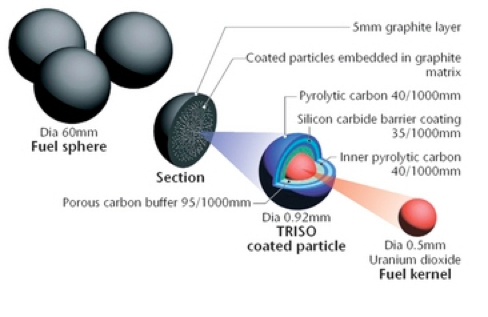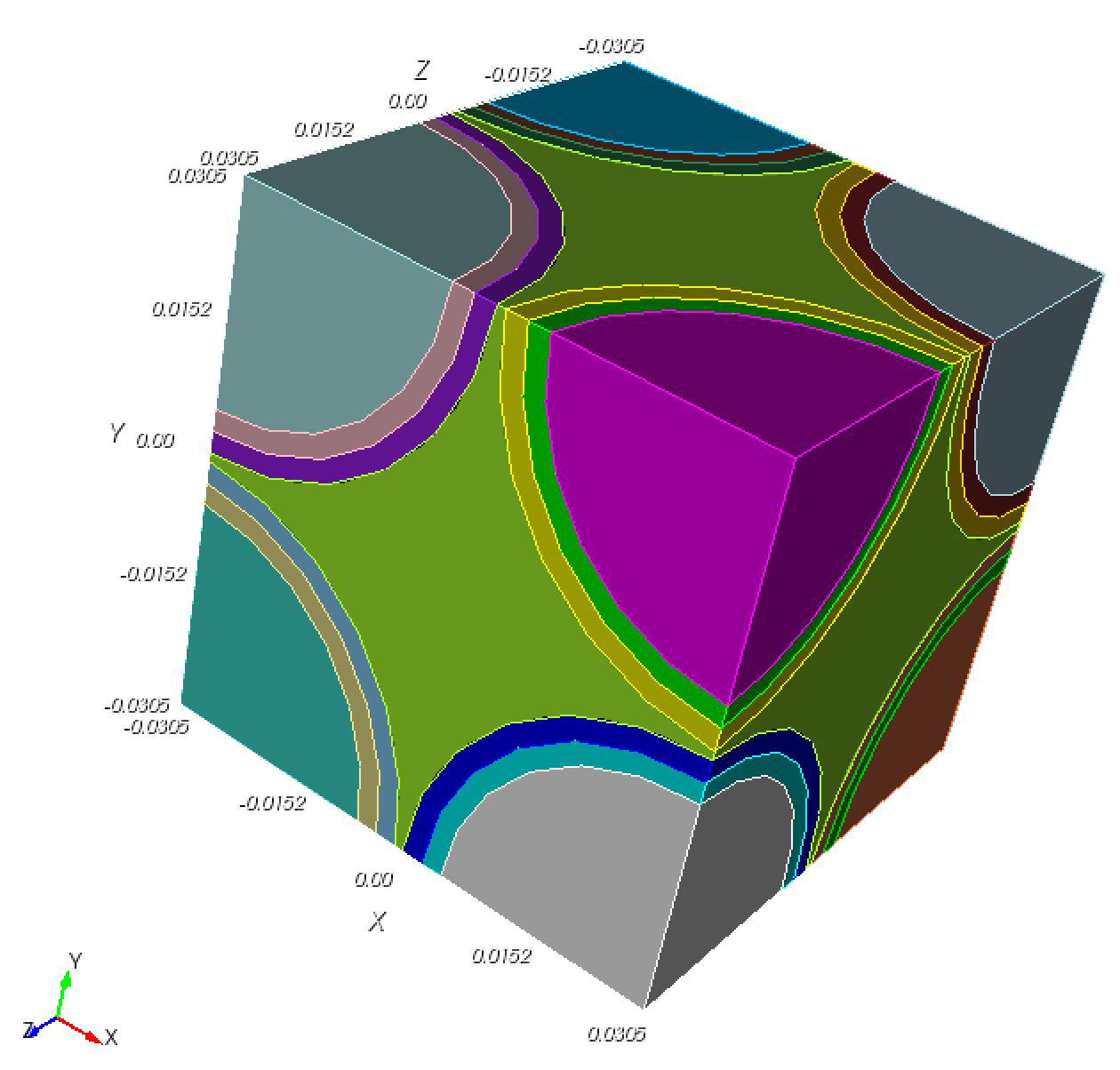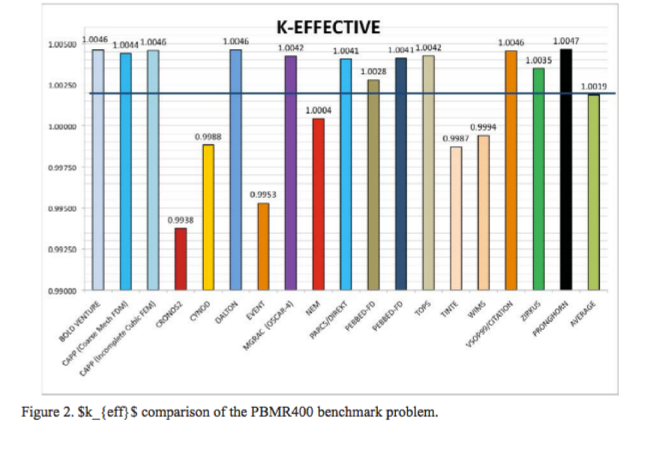Progress on Coupled Physics Modeling in Fluoride Salt Cooled High Temperature Reactors
Kathryn Huff
at Oak Ridge National Laboratory
March 03, 2016









Outline
- PB-FHR Design Overview
- TMSR-SF Design Overview
- Neutronics Benchmark Development
- 0D Transient Multiphyiscs Analysis
- 3D Transient Mutliphysics Progress
- Future work


PB-FHR Fuel Geometry

PB-FHR Mk1 Design
- MIT, UCB, UW FHR-IRP collaboration
- Reactor power: 236MWth
- Coolant Inlet: 600C
- FLiBe coolant
- Annular core
- Annular pebbles with TRISO particles
- Randomly packed bed
- Multi-pass fuel circulation
- High Temperatures
- Strong fuel temperature feedback
TMSR-SF
 Yu, 2016. TMSR-SF design, Chinese TMSR-SF and TMSR-LF Development, TMSR Research center, SINAP, CAS
Yu, 2016. TMSR-SF design, Chinese TMSR-SF and TMSR-LF Development, TMSR Research center, SINAP, CAS
TMSR-SF Fuel Geometry

TMSR-SF
- SINAP, CAS, ORNL collaboration
- Reactor power: 10MWth
- Coolant Inlet: 600C
- Coolant Outlet: 628C
- Fuel Element: 6cm Spherical elements, TRISO matrix
Neutronics Benchmark Development at UC Berkeley
Leads: Per Peterson, Max Fratoni, Manuele Aufiero, Lance Maul, Xin Wang, Dan Chen, Katy Huff, April Novak, et al.
Workshop in April at BerkeleyNeutronics Benchmark Development at UC Berkeley
- Two Reactor Types: PB-FHR and TMSR-SF
- Phase 1: Unit Cell
- Phase 2: Simplified Core
- Phase 3: Design Level Modeling
Lance Maul: Comparing MCNP, SERPENT, KENO results.
Manuele Aufiero: SERPENT analysis (with Open Foam TH).
Xin Wang: COMSOL model development.
Huff and Novak: MOOSE application development.
Huff and Novak: Benchmark geometry generation.
Phase 1

Phase 2

Phase 2

Phase 2

Phase 3


FHR Coupled, Transient Analysis
- Collect experimental data
- Conduct algebraic, static, and benchmark simulations
- Develop few group parameters, steady state results
- Develop 0D coupled neutronics/TH model (PyRK)
- Develop 3D neutronics/TH model
- Compare 0D and 3D simulations
- Couple additional physics (e.g. fuel performance)

PyRK: Python for Reactor Kinetics
Review of Nuclear Reactor Kinetics

\[\sigma(E,\vec{r},\hat{\Omega},T,x,i)\]

\[k=1\]


\[\beta_i, \lambda_{d,i}\]
PyRK
- 6-precursor-group,
- Point and Multi-Point Reactor Kinetics model
- Lumped Parameter thermal hydraulics model
- With finite volume pebble conduction model
- Object-oriented, geometry and material agnostic framework
Point Reactor Kinetics
\[ \begin{align} p &= \mbox{ reactor power }\\ \rho(t,&T_{fuel},T_{cool},T_{mod}, T_{refl}) = \mbox{ reactivity}\\ \beta &= \mbox{ fraction of neutrons that are delayed}\\ \beta_j &= \mbox{ fraction of delayed neutrons from precursor group j}\\ \zeta_j &= \mbox{ concentration of precursors of group j}\\ \lambda_{d,j} &= \mbox{ decay constant of precursor group j}\\ \Lambda &= \mbox{ mean generation time }\\ \omega_k &= \mbox{ decay heat from FP group k}\\ \kappa_k &= \mbox{ heat per fission for decay FP group k}\\ \lambda_{FP,k} &= \mbox{ decay constant for decay FP group k}\\ T_i &= \mbox{ temperature of component i} \end{align} \]Lumped Parameter Heat Transfer
The heat flow out of body $i$ is the sum of surface heat flow by conduction, convection, radiation, and other mechanisms to each adjacent body, $j$: \[ \begin{align} Q &= Q_i + \sum_j Q_{ij}\\ &=Q_i + \sum_j\frac{T_{i} - T_{j}}{R_{th,ij}}\\ \dot{Q} &= \mbox{total heat flow out of body i }[J\cdot s^{-1}]\\ Q_i &= \mbox{other heat transfer, a constant }[J\cdot s^{-1}]\\ T_i &= \mbox{temperature of body i }[K]\\ T_j &= \mbox{temperature of body j }[K]\\ j &= \mbox{adjacent bodies }[-]\\ R_{th} &= \mbox{thermal resistence of the component }[K \cdot s \cdot J^{-1}]. \end{align} \]Quality Control
Unit Checking

In PyRK, the Pint package (pint.readthedocs.org/en/0.6/) is used keeping track of units, converting between them, and throwing errors when unit conversions are not sane.
Version Control

Keeping track of versions of the code makes it possible to experiment without fear and placing the code online encourages use and collaboration.
Automated Documentation

Automated documentation creates a browsable website explaining the most recent version of the code.
Test Suite

The classes and functions that make up the code are tested individually for robustness using nose.
Continuous Integration

The tests are run every time a change is made to the repository online. The results are public. If a main branch has a failed test, I get an email.
PB-FHR Reactivity Insertion
Pebble-Bed, Fluoride Salt Cooled, High-Temperature Reactor
- Molten FLiBe Coolant
- Annular Core
- Annular Pebble Fuel
- Steady Inlet Temperature
- Ramp Reactivity Insertion, 600pcm over 10s
Components
fuel = th.THComponent(name="fuel",
mat=TRISO(),
vol=vol_fuel,
T0=t_fuel,
alpha_temp=alpha_fuel,
timer=ti,
heatgen=True,
power_tot=power_tot/n_pebbles,
sph=True,
ri=r_mod,
ro=r_fuel
)
mod = th.THComponent(name="mod",
mat=Graphite(),
vol=vol_mod,
T0=t_mod,
alpha_temp=alpha_mod,
timer=ti,
sph=True,
ri=0.0,
ro=r_mod)
cool = th.THComponent(name="cool",
mat=Flibe(),
vol=vol_cool,
T0=t_cool,
alpha_temp=alpha_cool,
timer=ti)
shell = th.THComponent(name="shell",
mat=Graphite(),
vol=vol_shell,
T0=t_shell,
alpha_temp=alpha_shell,
timer=ti,
sph=True,
ri=r_fuel,
ro=r_shell)
Heat Transfer
# The coolant convects to the pebbles
cool.add_convection('pebble', h=h_cool, area=a_pb)
cool.add_advection('cool', m_flow/n_pebbles, t_inlet, cp=cool.cp)
Ramp Reactivity Insertion

Ramp Reactivity Insertion
# External Reactivity
from reactivity_insertion import RampReactivityInsertion
rho_ext = RampReactivityInsertion(timer=ti,
t_start=t_feedback + 10.0*units.seconds,
t_end=t_feedback + 20.0*units.seconds,
rho_init=0.0*units.delta_k,
rho_rise=600.0*units.pcm,
rho_final=600.0*units.pcm)
Fuel Layer Temperature


Coolant Temperature


Ramp Duration Variation


Ramp Duration Variation


 \[66J/gUO2 << 1400J/gUO2 \]
\[66J/gUO2 << 1400J/gUO2 \]
MOOSE-Based Application Development

MOOSE Framework
- Finite Element Framework
- Jacobian-Free Newton Krylov
- Adaptively meshed geometry handling
- Scalability
PRONGHORN Capabilities
- Diffusion Neutronics
- Conjugate Heat Transfer
- Pebble Bed Darcy Flow (gaseous)
PRONGHORN PBMR-400 Benchmark

Single-Phase, Incompressible, Thermally-Expandable Flow
Continuity
\[ \begin{align} \frac{\partial \epsilon \rho_f}{\partial t} + \nabla(\epsilon \rho_f \vec{u}) &= 0\\ \end{align} \]Momentum
\[ \begin{align} \frac{\partial \epsilon \rho_f}{\partial t} + \nabla(\epsilon \rho_f \vec{u}\times\vec{u}) + \nabla \epsilon P - \epsilon \rho_f \vec{g} + W\rho_f\vec{u} =0\\ \end{align} \]Energy
\[ \begin{align} \frac{\partial\epsilon\rho_fH}{\partial t} + \nabla(\epsilon\rho_f\vec{u}H) &= q''' \end{align} \]Single-Phase, Incompressible, Thermally-Expandable Flow
Stabilization (SUPG/PSPG)
\[ \left\langle f_{continuity},\psi\right\rangle+\left\langle f_{mom,non},\tau_{pspg}\times\nabla\psi\right\rangle\\ \left\langle f_{mom},\psi\right\rangle+\left\langle f_{mom,non},\tau_{supg}\times\nabla\psi\right\rangle\\ \left\langle f_{energy},\psi\right\rangle+\left\langle f_{energy,non},\tau_{supg}\times\nabla\psi\right\rangle \]
Single-Phase, Incompressible, Thermally-Expandable Flow
Implementation testing underway.Future work
- 3D Steady State Neutronics, Fixed Cross Sections
- 3D Steady State Thermal Hydraulics, Fixed Power, Compare to COMSOL
- Coupled 3D Steady State N&TH
- Transients - LOFC, LOHS, LOLA, RIA
- Startup Modeling
- Randomly Packed Bed Hot Spot Analyses
- Xenon Stability
Links
Acknowledgements
- Massimiliano Fratoni
- Per Peterson
- Manuele Aufiero
- Xin Wang
- Lance Maul
- Dan Chen
- April Novak
- Jasmina Vujic
- and many more...



THE END
Katy Huff
katyhuff.github.io/2016-03-03-ornl
Progress on Coupled Physics Modeling in Fluoride Salt Cooled High Temperature Reactors by Kathryn Huff is licensed under a Creative Commons Attribution 4.0 International License.
Based on a work at http://katyhuff.github.io/2016-03-03-ornl.